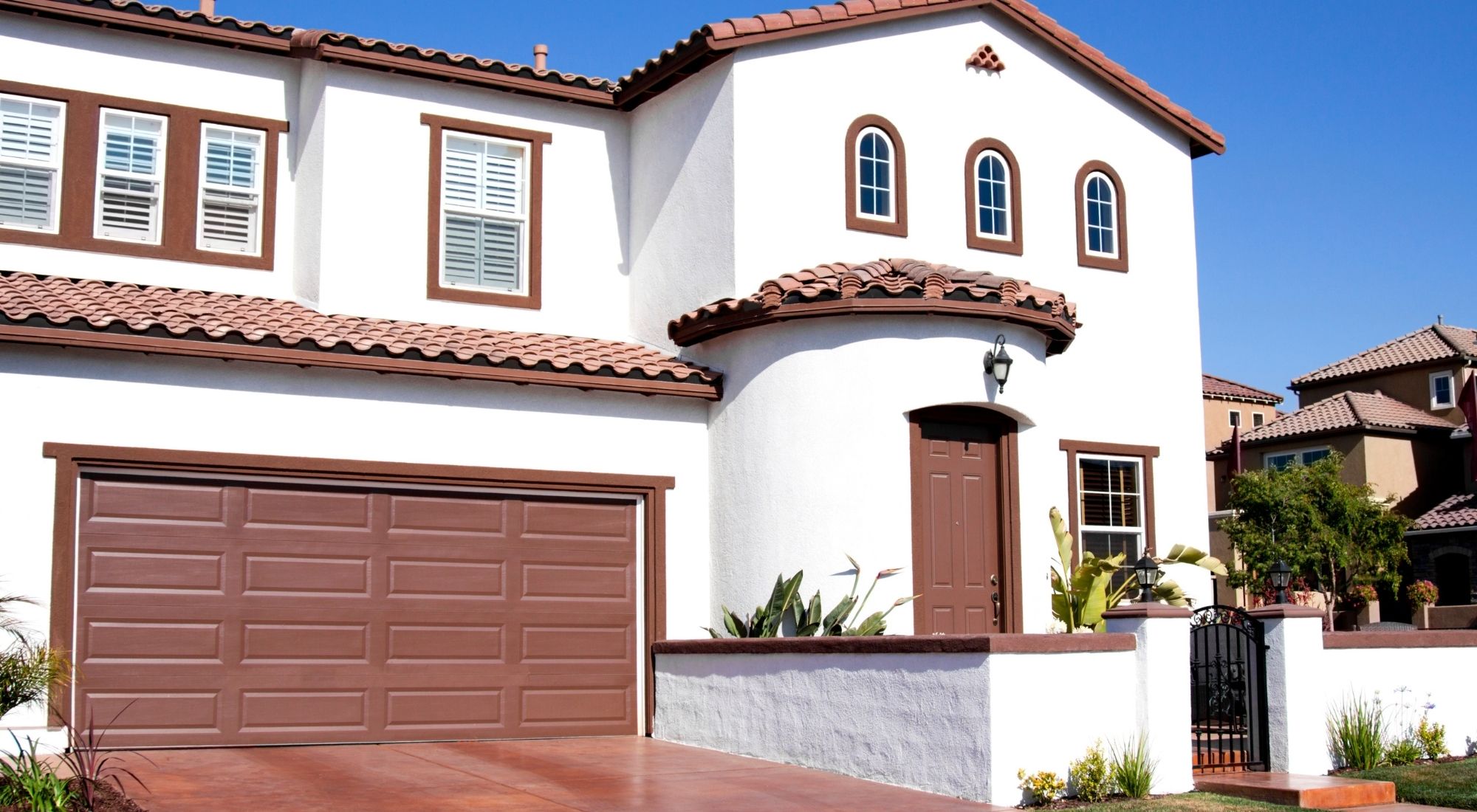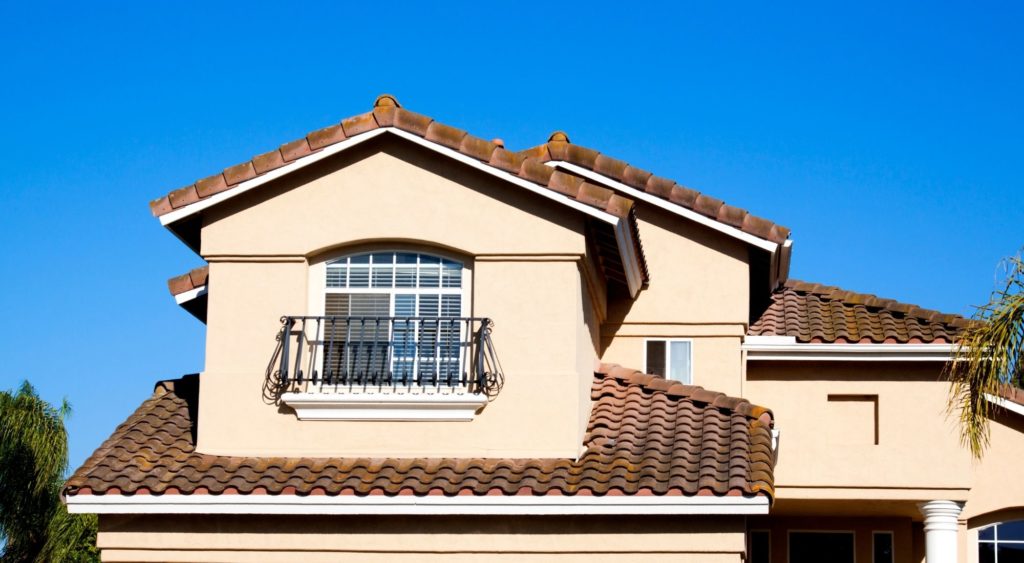While you love the distinctive style of your home’s stucco finish, its once classic look is starting to look shabby.
How do you freshen the look of stucco?
Can you paint a stucco house? And if you can, what steps should you take to make sure the job is done right?
Let the professionals answer your questions about stucco exterior, including whether stucco can be painted and how to get the new look you’re hoping for.
Table of Contents
- Can You Paint Stucco Exterior?
- 5 Advantages to Painting Over a Stucco Exterior
- 10 Ways to Avoid Mistakes When Painting Over a Stucco Exterior
Can You Paint Stucco Exterior?
The short answer is yes. But that doesn’t mean you should paint your stucco exterior.
Painting over a stucco exterior isn’t the same as painting over other types of exteriors, and is easy to mess up. There’s specialized prep work, cracks to fill, and a “knack” to applying the paint in just the right way.
This is definitely a time to call in the experts!
5 Advantages to Painting Over a Stucco Exterior
#1: Exterior Paint Can Cover Stains
If you look at the stucco exterior of your home, you probably see vertical water and rust stains — particularly underneath the window frames.
Painting over stucco can cover the unsightly spots and when the paint is applied properly (by professionals), it can prevent new stains from forming.
#2: Exterior Paint Can Fill Hairline Cracks
If you have a stucco exterior on your home, you know stucco is notorious for cracking. If left unrepaired and unpainted, tiny cracks will only become a bigger problem over time and make repairs even more costly.
Painting stucco with a high-quality, flat, latex paint can fill those hairline cracks and protect the integrity of your stucco exterior for years to come.
#3: Exterior Paint Can Prevent UV Ray Damage
If your home is in a bright, sunny location, ultraviolet rays can wreak havoc on your stucco exterior — leading to masonry cracks and structural damage that reduce its durability and longevity.
When stucco cracks are left unrepaired, structural changes occur which compromise the functionality of the stucco.
Painting your stucco helps deflect the damaging UV rays, keeping your home’s exterior properly insulated and well protected.
#4: Exterior Paint Can Boost Curb Appeal
Whether you’re wanting to keep your home looking its best for the next generation of homeowners, or are in the market to sell, one of the best ways to improve your home’s curb appeal and make it stand out is a fresh coat of paint.
Painting over a stucco exterior is a simple and effective way to improve the appearance of your home and creates an attractive, classic look that will stand the test of time.
#5: Exterior Paint Helps Prevent Moisture Damage
Stucco is a porous material. That’s why after a rainstorm, it absorbs water and takes on a darker appearance until it dries.
When your stucco exterior is properly prepped and painted, the paint waterproofs the stucco. This effectively seals it to keep moisture from penetrating and causing damage to the stucco and the material underneath.
Preventing damaging moisture from entering stucco will help your home’s exterior maintain its attractive appearance for years to come.
10 Ways to Avoid Mistakes When Painting Over a Stucco Exterior
#1: Make Sure Your Stucco Isn’t Actually EIFS Siding
EIFS, Exterior Insulation Finishing System (also known as synthetic stucco), is a thin, brittle skim coat that is applied to homes in the Pacific Northwest.
The problem with EIFS is twofold:
- EIFS is a Southwestern product that was specifically designed for drier climates — not for the cool, damp weather conditions of the Pacific Northwest.
- EIFS is highly susceptible to water damage, and when Improperly sealed, allows water to ravage your home’s exterior, causing:
- Moisture accumulation
- Damage to the underlying wood
- Mold growth; and
- Easy entry for pests such as termites and carpenter ants
#2: Ensure the Stucco Is Cured Before Painting
If you are painting over new stucco, you will need to allow it to cure for 60-75 days before painting — or longer in rainy weather. Always consult with a professional to find out what’s recommended in your area.
This is because the excess lime in the stucco needs time to leach out. If you paint it prematurely, the lime will leach through the paint film, causing the film to peel and crack.
If the curing process is rushed, the stucco’s surface will quickly begin to crumble and deteriorate.
#3: Never Paint Over Wet Stucco
You should never paint over any wet surface, especially stucco. Due to its porous nature, stucco takes longer to dry, so make sure to wait for it to completely dry before applying your first coat of paint.
You will also want to let each coat of paint dry completely before applying the next.
#4: Make Sure Cracks and Holes Are Repaired Before Painting
It’s critical for all cracks and holes to be filled with caulking before painting over a stucco exterior.
Failure to properly complete this step means water can enter the stucco, even through paint, causing more damage and mold growth.
But not just any caulk will do. Because stucco is a porous material, the caulking must be a flexible, exterior acrylic to accommodate the natural swelling of stucco. Larger cracks may require masonry patching for proper repair.
A professional will know which material will be best for the needed repairs on your home’s exterior.
#6: Clean the Stucco Before Applying Paint
Paint won’t stick to a dirty surface.
If your stucco isn’t clean — and completely dry — the paint will quickly begin to flake and peel.
The easiest and fastest way to remove the dirt and grime from stucco is by pressure washing at 1,500 to 2,500 PSI, or pounds per square inch. If your stucco is particularly dirty, you may scrub it with a mild, eco-friendly detergent.
Be sure to test first in an inconspicuous location before taking on the whole house, and always allow patched stucco to dry for at least 15-30 days before washing.
#7: Use Primer
If this is the first time your home’s stucco has been painted, you will need to prime it first with a high-quality acrylic primer. Use a large, napped roller to roll the primer on and a synthetic brush to cut in.
Acrylic primer is preferred because the binders in the product provide the best adherence to stucco’s uneven finish.
#8: Use the Right Kind of Paint
The best paint for stucco is two coats of flat latex. This type of paint allows the stucco to “breathe.”
Using rubberized paints can cause damage to the paint job since there is no vapor transmission between the cement and air. As the weather warms, the paint begins to off-gas. Rather than letting the vapor escape, the composition of rubberized paint creates a blister that will bubble and eventually pop.
#9: Ensure the Paint Is Applied Properly
The best methods for painting stucco are an airless sprayer or roller. The airless sprayer makes larger projects go quickly, while the roller works fine for smaller jobs.
Brushes are only recommended for detailing.
If you are painting over highly-textured stucco, you will need to back-roll with a paint roller to get a high-quality finish. Depending on the condition of the stucco, you may need to use more than one coat of paint.
#10: Hire a Professional Painting Company
Let’s face it. There’s a lot involved in painting over a stucco exterior.
And while you can paint stucco on a house, a complicated job like this requires skills that most do-it-yourself painters don’t have. A stucco paint job is best left to the professionals — like Two Brothers Painting.
With over 14 years of combined experience, the experts at Two Brothers Painting know all the tricks to painting over a stucco exterior.
Two Brothers Painting has the training, tools, and know-how needed to get your interior or exterior paint job done quickly, efficiently — and right.
Call today or schedule an estimate online and take the first step towards a new look.




